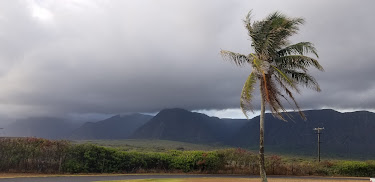Here are some photos from our trip to the Manakalua peninsula on Molokai. It turns out that Blogger posts these in the reverse order that I selected, so you may want to scroll to the bottom and read your way up.
A view of the peninsula looking south, with the sea cliffs beyond.
The detached kitchen.
The view from the kitchen window.
A typical house in the Kalaupapa settlement. Houses are provided for residents, National Park Service workers, and medical staff from the Department of Health.
A shot of the patient's crafts room, now abandoned.
Here Ronnie and I have climbed partway up the sea cliff. The settlement can be seen on the coast in the distance.
This is the terrain along the single pathway that can be used to go up and down the cliffs. It's very time consuming with lots of switchbacks.
A view of the Long House. Patients would enter one side and visitors the other. A table and screen separated the two so there was no contact.
St. Philomena Catholic Church is in the heart of the settlement and still active. There are two nuns in residence. While we were there, Father Pat had two guests: a priest from Anaheim, California and a nun from Portland, Oregon. The sister had a great deal of experience with Hansen's Disease patients in Vietnam, where there is scant access to medications. She told me there are three colonies in Vietnam for patients and showed me a number of photos of patients with severe consequences including missing digits and severe skin damage.
Near the visitors' quarters, on the flat peninsula with the sea cliffs beyond.
The lava covered coastline.
My room in the visitors' quarters. Cool air comes from the breeze. There is an electrical outlet and a ceiling light. The bathroom is at the end of the hall. Many of the buildings on the campus date from the 1940s to 1950s, with some going back to the 1800s. The National Park Service staff have their hands full maintaining the remaining buildings. Both termites and fires are a major threat. Some buildings have fallen into disrepair.
Hallway in the visitors' quarters. Jalousie windows are the standard here for letting in breezes. They are also quite common in Honolulu in the many homes that do not have air conditioning.
A pretty rainbow over the cliff. The staff living on Kaluapapa call the rest of Molokai "topside" because the entire island aside from their 2 x 2.5 mile peninsula lies above the cliffs.
The Kalaupapa lighthouse, located at the tip of the peninsula near the airport (actually a landing strip).
The spectacular views looking east from Kalawao. At one time, there were patients on both the Kalawao side, which is windward/east, and the Kalaupapa side, which is leeward/west. Many years ago, all patients were moved to Kalaupapa because the weather is less harsh on that side.
Enjoying the view.
Visiting one of the old churches on the Kalawao side of the peninsula.
The peninsula is notable for the many cemeteries where former patients and staff reside. There are said to be 1,000 known gravesites, and perhaps 8,000 burials in total. At its peak, the colony was home to 1,200 patients.
We snuck up on a monk seal lounging on the beach. We also saw lots of deer, mountain goats, wild pigs, and mongoose.
Entering the Kalaupapa National Historical Park.
Many thanks to nurse supervisor Veronica "Ronnie" Mitchell (center) for sponsoring Jackie and me for this trip.
The Manakalua peninsula as seen from the air. The Kalaupapa settlement is on the water's edge in the foreground, and the sea cliffs that blocked escape are behind it.
The sea cliffs of Molokai are some of the tallest in the world and provided a natural barrier to keep patients on the Kalaupapa settlement.
We flew east from Honolulu, here were are passing Diamond Head crater and the east end of Oahu.





























No comments:
Post a Comment